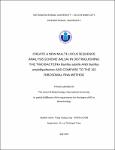| dc.description.abstract | A Multi Locus sequence analysis (MLSA) approach was established and performed on the two
species that belong to Bacillus genus: Bacillus subtilis and Bacillus amyloliquefaciens, consisting
of five strains (3 strains from B. subtilis and 2 strains from B. amyloliquefaciens) were provided
by Biotechnology Center of Ho Chi Minh City. The study was based on sequences of 16S rRNA
genes and the concatenate of five protein-coding housekeeping genes: glycerol uptake facilitator
(glpF), phosphotransacetylase (ptA), phosphoribosyl aminoimidazole carboxamide formyl
transferase (purH), pyruvate carboxylase (pycA), and RNA polymerase sigma factor (rpoD). After
PCR amplification and sequencing, phylogenetic tree of 16S rRNA sequences and concatenate
sequences (as well as phylogenetic tree of each housekeeping gene for supplementary) are
constructed for comparison and discussion. The results show that using Multi Locus sequence
analysis scheme can distinguish B. subtilis and B. amyloliquefaciens from each other and from
other Bacillus species better than using traditional 16S rRNA genes. In conclusion, using Multi
Locus sequence analysis scheme can reach for better resolution and differentiation of strains and
can be developed in applying to the whole genus Bacillus | en_US |


